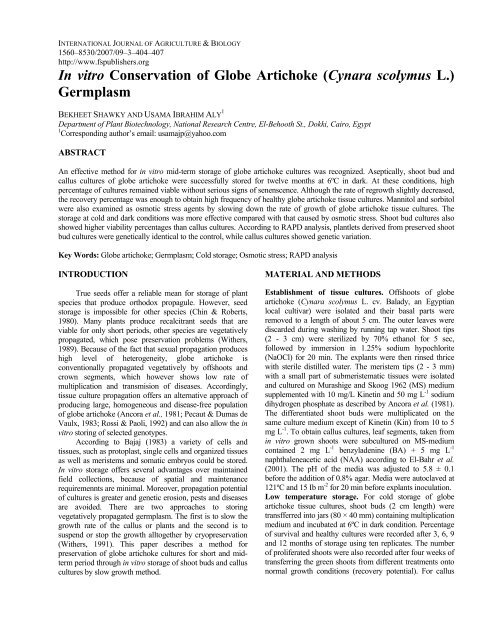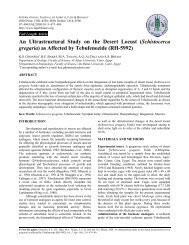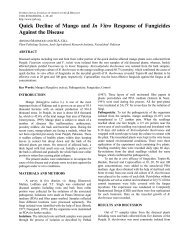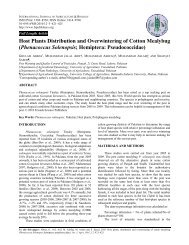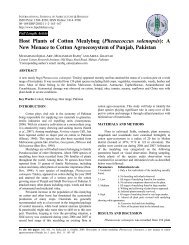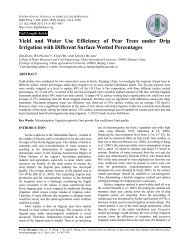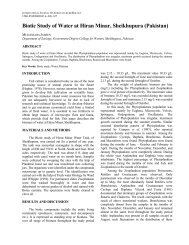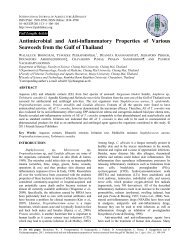In vitro Conservation of Globe Artichoke (Cynara scolymus L ...
In vitro Conservation of Globe Artichoke (Cynara scolymus L ...
In vitro Conservation of Globe Artichoke (Cynara scolymus L ...
Create successful ePaper yourself
Turn your PDF publications into a flip-book with our unique Google optimized e-Paper software.
INTERNATIONAL JOURNAL OF AGRICULTURE & BIOLOGY<br />
1560–8530/2007/09–3–404–407<br />
http://www.fspublishers.org<br />
<strong>In</strong> <strong>vitro</strong> <strong>Conservation</strong> <strong>of</strong> <strong>Globe</strong> <strong>Artichoke</strong> (<strong>Cynara</strong> <strong>scolymus</strong> L.)<br />
Germplasm<br />
BEKHEET SHAWKY AND USAMA IBRAHIM ALY 1<br />
Department <strong>of</strong> Plant Biotechnology, National Research Centre, El-Behooth St., Dokki, Cairo, Egypt<br />
1 Corresponding author’s email: usamajp@yahoo.com<br />
ABSTRACT<br />
An effective method for in <strong>vitro</strong> mid-term storage <strong>of</strong> globe artichoke cultures was recognized. Aseptically, shoot bud and<br />
callus cultures <strong>of</strong> globe artichoke were successfully stored for twelve months at 6ºC in dark. At these conditions, high<br />
percentage <strong>of</strong> cultures remained viable without serious signs <strong>of</strong> senenscence. Although the rate <strong>of</strong> regrowth slightly decreased,<br />
the recovery percentage was enough to obtain high frequency <strong>of</strong> healthy globe artichoke tissue cultures. Mannitol and sorbitol<br />
were also examined as osmotic stress agents by slowing down the rate <strong>of</strong> growth <strong>of</strong> globe artichoke tissue cultures. The<br />
storage at cold and dark conditions was more effective compared with that caused by osmotic stress. Shoot bud cultures also<br />
showed higher viability percentages than callus cultures. According to RAPD analysis, plantlets derived from preserved shoot<br />
bud cultures were genetically identical to the control, while callus cultures showed genetic variation.<br />
Key Words: <strong>Globe</strong> artichoke; Germplasm; Cold storage; Osmotic stress; RAPD analysis<br />
INTRODUCTION<br />
True seeds <strong>of</strong>fer a reliable mean for storage <strong>of</strong> plant<br />
species that produce orthodox propagule. However, seed<br />
storage is impossible for other species (Chin & Roberts,<br />
1980). Many plants produce recalcitrant seeds that are<br />
viable for only short periods, other species are vegetatively<br />
propagated, which pose preservation problems (Withers,<br />
1989). Because <strong>of</strong> the fact that sexual propagation produces<br />
high level <strong>of</strong> heterogeneity, globe artichoke is<br />
conventionally propagated vegetatively by <strong>of</strong>fshoots and<br />
crown segments, which however shows low rate <strong>of</strong><br />
multiplication and transmision <strong>of</strong> diseases. Accordingly,<br />
tissue culture propagation <strong>of</strong>fers an alternative approach <strong>of</strong><br />
producing large, homogeneous and disease-free population<br />
<strong>of</strong> globe artichoke (Ancora et al., 1981; Pecaut & Dumas de<br />
Vaulx, 1983; Rossi & Paoli, 1992) and can also allow the in<br />
<strong>vitro</strong> storing <strong>of</strong> selected genotypes.<br />
According to Bajaj (1983) a variety <strong>of</strong> cells and<br />
tissues, such as protoplast, single cells and organized tissues<br />
as well as meristems and somatic embryos could be stored.<br />
<strong>In</strong> <strong>vitro</strong> storage <strong>of</strong>fers several advantages over maintained<br />
field collections, because <strong>of</strong> spatial and maintenance<br />
requiremennts are minimal. Moreover, propagation potential<br />
<strong>of</strong> cultures is greater and genetic erosion, pests and diseases<br />
are avoided. There are two approaches to storing<br />
vegetatively propagated germplasm. The first is to slow the<br />
growth rate <strong>of</strong> the callus or plants and the second is to<br />
suspend or stop the growth alltogether by cryopreservation<br />
(Withers, 1991). This paper describes a method for<br />
preservation <strong>of</strong> globe artichoke cultures for short and midterm<br />
period through in <strong>vitro</strong> storage <strong>of</strong> shoot buds and callus<br />
cultures by slow growth method.<br />
MATERIAL AND METHODS<br />
Establishment <strong>of</strong> tissue cultures. Offshoots <strong>of</strong> globe<br />
artichoke (<strong>Cynara</strong> <strong>scolymus</strong> L. cv. Balady, an Egyptian<br />
local cultivar) were isolated and their basal parts were<br />
removed to a length <strong>of</strong> about 5 cm. The outer leaves were<br />
discarded during washing by running tap water. Shoot tips<br />
(2 - 3 cm) were sterilized by 70% ethanol for 5 sec,<br />
followed by immersion in 1.25% sodium hypochlorite<br />
(NaOCl) for 20 min. The explants were then rinsed thrice<br />
with sterile distilled water. The meristem tips (2 - 3 mm)<br />
with a small part <strong>of</strong> submeristematic tissues were isolated<br />
and cultured on Murashige and Skoog 1962 (MS) medium<br />
supplemented with 10 mg/L Kinetin and 50 mg L -1 sodium<br />
dihydrogen phosphate as described by Ancora et al. (1981).<br />
The differentiated shoot buds were multiplicated on the<br />
same culture medium except <strong>of</strong> Kinetin (Kin) from 10 to 5<br />
mg L -1 . To obtain callus cultures, leaf segments, taken from<br />
in <strong>vitro</strong> grown shoots were subcultured on MS-medium<br />
contained 2 mg L -1 benzyladenine (BA) + 5 mg L -1<br />
naphthaleneacetic acid (NAA) according to El-Bahr et al.<br />
(2001). The pH <strong>of</strong> the media was adjusted to 5.8 ± 0.1<br />
before the addition <strong>of</strong> 0.8% agar. Media were autoclaved at<br />
121ºC and 15 Ib m -2 for 20 min before explants inoculation.<br />
Low temperature storage. For cold storage <strong>of</strong> globe<br />
artichoke tissue cultures, shoot buds (2 cm length) were<br />
transfferred into jars (80 × 40 mm) containing multiplication<br />
medium and incubated at 6ºC in dark condition. Percentage<br />
<strong>of</strong> survival ِand healthy cultures were recorded after 3, 6, 9<br />
and 12 months <strong>of</strong> storage using ten replicates. The number<br />
<strong>of</strong> proliferated shoots were also recorded after four weeks <strong>of</strong><br />
transferring the green shoots from different treatments onto<br />
normal growth conditions (recovery potential). For callus
GLOBE ARTICHOKE GERMPLASM CONSERVATION / <strong>In</strong>t. J. Agri. Biol., Vol. 9, No. 3, 2007<br />
storage, equal inocula (250 mg) <strong>of</strong> callus were transferred to<br />
callus maintaining medium and incubated at 6ºC in dark<br />
condition.<br />
Measurement <strong>of</strong> callus growth. Callus growth, expressed<br />
as fresh and dry weights and growth value were determined<br />
after 3, 6, 9 and 12 months <strong>of</strong> cultivation. The callus<br />
cultures were washed thrice with deionized water, filtered<br />
and weighed as fresh weight then dried at 60ºC overnight in<br />
an oven for dry weight measurement. Ten replicates <strong>of</strong><br />
either shoot buds or callus at each storage period were used<br />
in this experiment. The growth value was calculated as<br />
follows:<br />
Final fresh weight – <strong>In</strong>itial fresh weight<br />
Growh value = –––––––––––––––––––––––––––––––––<br />
<strong>In</strong>itial fresh weight<br />
Osmotic stress storage. To evaluate the role <strong>of</strong> mannitol<br />
and sorbitol as osmotic agents, shoot buds <strong>of</strong> globe<br />
artichoke were grown on shoot multiplication medium<br />
supplemented with 40 g L -1 <strong>of</strong> either mannitol or sorbitol<br />
and incubated under normal growth conditions. Survival<br />
and healthy culture percentages were calculated from ten<br />
replicates after 3, 6, 9 and 12 months <strong>of</strong> storage. For callus<br />
storage, pieces <strong>of</strong> callus tissues (250 mg each) were<br />
subcultured on callus maintaining medium containing<br />
mannitol or sorbitol and then stored at normal growth<br />
conditions. Culture media were adjusted to pH 5.8 before<br />
autoclaving at 121ºC and 15 Ib m -2 for 20 min. The cultures<br />
were stored at 25 ± 2ºC under 16 h photoperiod with light<br />
irradiance <strong>of</strong> 45 µmol m -1 s - ¹ (Phillips white fluorescent<br />
tubes). Ten replicates were collected after 3, 6, 9 and 12<br />
months storage. Fresh and dry weights were measured and<br />
growth value was calculated.<br />
Randomly amplified polymorphic DNA (RAPD)<br />
analysis. DNA isolation was performed using the Cetyl<br />
Trimethyl Ammonium Bromide (CTAB) method <strong>of</strong> Doyle<br />
and Doyle (1987). Half grams <strong>of</strong> fresh samples was ground<br />
to powder in liquid nitrogen with a pre-chilled pestle and<br />
mortar, suspended in 5 mL preheated CTAB buffer and<br />
incubated at 65°C for 1 h with occasional shaking. The<br />
suspension was then mixed with 1/3 volume <strong>of</strong> chlor<strong>of</strong>orm,<br />
mixed gently, centrifuged and the upper phase was<br />
transferred to a new sterilized tube. Extraction was repeated<br />
with an equal volume <strong>of</strong> chlor<strong>of</strong>orm. The aqueous layer was<br />
transferred to a new tube, 2/3 volume <strong>of</strong> isopropanol was<br />
added and nucleic acids were either spooled using a Pasteur<br />
pipette or precipitated by centrifugation. The pellet was<br />
washed carefully twice with 70% ethanol, dried at room<br />
temperature and re-suspended in 0.5 mL TE buffer. The<br />
enzyme, RNAse (20 μg), was added to the re-suspended<br />
mixture to digest any contaminating RNA and the tube was<br />
incubated at 37˚C for 30 min. To remove the enzyme and<br />
other contaminating protein, phenol/chlor<strong>of</strong>orm extraction<br />
was performed. The polymerase chain reaction (PCR)<br />
mixture (25 uL) consisted <strong>of</strong> 0.8 units <strong>of</strong> Taq DNA<br />
polymerase, 25 pmol dNTPs and 25 pmol <strong>of</strong> random primer<br />
405<br />
and 50 ng <strong>of</strong> genomic DNA. Thermocycler programmed for<br />
45 cycles as follow: 94ºC/5 min (1 cycle), 94ºC/30 sec,<br />
36ºC/30 sec, 72ºC/2 min (45 cycle) and 72ºC/7 min (1<br />
cycle), then hold at 4ºC. The amplified DNA fragments<br />
were separated on 2% agarose gel and stained with ethidium<br />
bromide. Three oligonucleotide primers 10-base (Operon<br />
technologies <strong>In</strong>c., Alameda, California) were randomly<br />
selected and used in RAPD analysis. The primers are K1<br />
(TGGCGACCTG), K2 (GAGGCGTCGC) and K4<br />
(TCGTTCCGC). A 100 bp DNA ladder (Promga) was used<br />
as a marker with molecular size <strong>of</strong> 1000, 900, 800, 700, 600,<br />
500, 400, 300, 200 and 100 bp. The amplified pattern was<br />
visualized on a UV transilluminator and photographed.<br />
Statistical analysis. Experiments were run in completely<br />
randomized design and data were statistically analyzed<br />
using standard error (SE) according to the method described<br />
by Snedecor and Cochran (1967).<br />
RESULTS AND DISCUSSION<br />
Storage at low temperature. Table I shows the percentage<br />
<strong>of</strong> survival and the healthy shoot bud cultures and the mean<br />
number <strong>of</strong> proliferated shoots retrieved from storage. After<br />
three months storage at 6ºC in dark, shoot buds showed high<br />
percentage <strong>of</strong> viability (100%) and healthy shoots (90%). A<br />
decline in both was recorded thereafter with increasing the<br />
duration <strong>of</strong> storage to 6, 9 and 12 months. The number <strong>of</strong><br />
proliferated shoots after recovery also followed the same<br />
trend (Table I). Although the lowest percentage <strong>of</strong> survived<br />
shoot buds (50%) was recorded after 12 months <strong>of</strong> storage,<br />
most <strong>of</strong> these buds were viable enough to convert into<br />
healthy shoots on recovery (Table I, Fig. 1a, b).<br />
The results <strong>of</strong> globe artichoke callus cultures reveal<br />
that stored cultures remained healthy without any serious<br />
signs <strong>of</strong> senescence during different storage periods. Callus<br />
growth presented as fresh and dry cell weight as well as<br />
growth value increased with storage duration until the ninth<br />
month. A deterioration in all parameters tested (Table II),<br />
with slight browning <strong>of</strong> the preserved callus, was then<br />
noticed after 12 months <strong>of</strong> storage. Engelmann (1991)<br />
reported that growth reduction could be achieved by<br />
modifying the environmental conditions and/or the culture<br />
medium. He added that, the most widely applied technique<br />
is temperature reduction, which can be combined with a<br />
decrease in light intensity or culture in dark. The present<br />
results are also in accordance with those reported by<br />
Bekheet (2000), in his study on Asparagus <strong>of</strong>ficinalis. He<br />
mentioned that tissue cultures remained viable after eighteen<br />
months <strong>of</strong> storage at 5ºC. <strong>In</strong> addition, 80% <strong>of</strong> pear and 85%<br />
<strong>of</strong> apple shoot bud cultures grown in <strong>vitro</strong> remained alive<br />
after eighteen months storage at 4ºC and 8ºC, respectively<br />
(Wanas et al., 1986; Wanas, 1992). <strong>In</strong> this respect,<br />
strawberry (Fragaria ananassa) plantlets have been stored<br />
at 4ºC in the dark and remained viable for 6 years with the<br />
regular addition <strong>of</strong> a few drops <strong>of</strong> fresh liquid medium<br />
(Mullin & Schlegel, 1976). Moreover, Dodds (1988)
eported that at temperature lower than 3ºC, in <strong>vitro</strong> potato<br />
cultures experienced frost damage, but 6ºC seem to be well<br />
tolerated.<br />
Osmotic stress storage. Storage by changing in the<br />
composition <strong>of</strong> the culture medium involves the addition <strong>of</strong><br />
osmotica. <strong>In</strong> the present study, modification <strong>of</strong> storage<br />
medium by incorporating 40 g L -1 <strong>of</strong> mannitol or sorbitol<br />
was investigated. Results indicate that the presence <strong>of</strong><br />
mannitol or sorbitol in culture medium had a retardant effect<br />
on the growth and development <strong>of</strong> all cultures. Data <strong>of</strong><br />
reveal that high percentage <strong>of</strong> survival (100%) and healthy<br />
shoot bud cultures (80%) were recorded after the first three<br />
months <strong>of</strong> storage on medium containing 40 g L -1 mannitol<br />
or sorbitol at normal growth conditions (Table I). However,<br />
survival and healthy shoot cultures were sharply decreased<br />
after six months <strong>of</strong> storage. After twelve months, high<br />
percentage <strong>of</strong> cultures suffered from etiolation. Proliferation<br />
SHAWKY AND ALY / <strong>In</strong>t. J. Agri. Biol., Vol. 9, No. 3, 2007<br />
Table I. Percentage <strong>of</strong> survival and healthy shoots and number <strong>of</strong> proliferated recovered shoots afterstorage for 3,<br />
6, 9 or 12 months under 6ºC or osmotic stress induced by 40 g/L mannitol or sorbitol. Each value is the mean ± S.E.<br />
<strong>of</strong> 10 replicates<br />
Storage duration<br />
(months)<br />
3<br />
6<br />
9<br />
12<br />
6 ºC<br />
100<br />
80<br />
60<br />
50<br />
Survival (%)<br />
Mannitol<br />
100<br />
70<br />
50<br />
30<br />
Sorbitol<br />
100<br />
60<br />
50<br />
20<br />
6 ºC<br />
90<br />
60<br />
50<br />
30<br />
Healthy shoots (%)<br />
Mannitol Sorbitol<br />
80 80<br />
50 50<br />
30 30<br />
20 10<br />
406<br />
No. <strong>of</strong> proliferated shoots after recovery<br />
6 ºC Mannitol Sorbitol<br />
5.50 ± 0.25 4.30 ± 0.15 4.00 ±0.20<br />
4.00 ± 0.33 3.70 ± 0.18 3.20 ± 0.18<br />
2.50 ± 0.50 2.10 ± 0.35 1.75 ± 0.25<br />
1.80 ± 0.30 1.50 ± 0.40 1.10± 0.50<br />
Table II. Growth dynamics <strong>of</strong> globe artichoke callus cultures during storage for 3, 6, 9 or 12 months at low<br />
temperature <strong>of</strong> 6ºC or osmotic stress induced by 40 g/L mannitol or sorbitol. Each value is the mean ± S.E. <strong>of</strong> 10<br />
replicates. <strong>In</strong>itial fresh weight is 250 mg<br />
Storage duration<br />
(month)<br />
3<br />
6<br />
9<br />
12<br />
Fresh weight (g)<br />
6 ºC Mannitol Sorbitol<br />
1.25 ± 0.13 1.20 ± 0.10 1.00 ± 0.19<br />
1.80 ± 0.30 1.50 ± 0.15 1.22 ± 0.30<br />
2.00 ± 0.20 1.60 ± 0.23 1.45 ± 0.10<br />
1.75 ± 0.25 1.10 ± 0.25 0.90 ± 0.30<br />
6 ºC<br />
131.25 ± 14.00<br />
180.00 ± 20.00<br />
190.00 ± 19.00<br />
166.70 ± 22.70<br />
Fig. 1a. Shoot bud <strong>of</strong> globe artichoke after twelve<br />
months <strong>of</strong> storage at 6ºC in dark, (b) Proliferated<br />
shoots after transferred to normal growth conditions<br />
for recovery<br />
Dry weight (mg)<br />
Mannitol Sorbitol<br />
126.30 ± 10.50 105.20 ± 20.00<br />
155.20 ± 15.00 120.00 ± 29.40<br />
150.80 ± 21.90 138.00 ± 9.50<br />
104.80 ± 22.70 81.80 ± 18.00<br />
6 ºC<br />
4.00<br />
6.20<br />
7.00<br />
6.00<br />
Growth value<br />
Mannitol Sorbitol<br />
3.80 3.00<br />
5.00 3.88<br />
5.40 4.80<br />
3.40 2.60<br />
rates <strong>of</strong> recovered shoots decreased as storage duration<br />
increased (Table I). No clear difference between mannitol<br />
and sorbitol in their effect on survival <strong>of</strong> stored shoot<br />
cultures <strong>of</strong> globe artichoke was observed. However,<br />
mannitol showed slightly positive effect on the proliferation<br />
rate <strong>of</strong> recovered shoot cultures.<br />
Growth dynamics <strong>of</strong> callus cultures <strong>of</strong> globe artichoke<br />
stored on modified medium supplemented with 40 g L -1 <strong>of</strong><br />
mannitol or sorbitol presented as fresh and dry weights and<br />
growth value were increased with increasing the storage<br />
duration until the ninth month then decreased after 12<br />
months storage (Table II). Raising the osmolarity <strong>of</strong> the<br />
medium leads to less dramatic results, but might, in<br />
combination with a reduced temperature, help to prolong<br />
storage period (Kartha et al., 1981). The results <strong>of</strong> the<br />
present investigation agree with those reported by Bekheet<br />
et al. (2001), who mentioned that at normal temperature,<br />
shoot and callus cultures <strong>of</strong> date palm survived for nine and<br />
six months under osmotic stress on medium containing 40<br />
mg L -1 sorbitol. They also found that low temperature and<br />
dark conditions were more effective for the storage <strong>of</strong> date<br />
palm tissue cultures compared with osmotic stress storage.<br />
However, in <strong>vitro</strong> shoot cultures <strong>of</strong> asparagus survived for<br />
20 months when stored on medium containing 3% sucrose<br />
and 4% sorbitol (Fletcher, 1994). <strong>In</strong> this respect,<br />
replacement <strong>of</strong> sucrose by ribose allowed the conservation<br />
<strong>of</strong> banana plantlets for 24 months (Ko et al., 1991).<br />
RAPD analysis. RAPD analysis was used in this study to<br />
determine the genetic stability <strong>of</strong> preserved tissue cultures <strong>of</strong><br />
globe artichoke. Genetic marker analysis has been used to<br />
study the degree <strong>of</strong> genetic change in plants regenerated in<br />
<strong>vitro</strong> such as pea (Cecchini et al., 1992), sugar beet (Sabir et<br />
al., 1992) and wheat (Brown et al., 1993). Three randomly<br />
selected primers were used and only one (K4) did not give<br />
reproducible and sufficient amplification products. As<br />
shown in Fig. 2, DNA fragments varied in numbers and<br />
sizes depending on the primers used. The banding reveals
GLOBE ARTICHOKE GERMPLASM CONSERVATION / <strong>In</strong>t. J. Agri. Biol., Vol. 9, No. 3, 2007<br />
Fig. 2. RAPD pr<strong>of</strong>ile <strong>of</strong> shoot bud cultures grown in<br />
<strong>vitro</strong> under standard conditions, (lane 1), in <strong>vitro</strong> cold<br />
preserved plantlets, (lane 2) and un-differentiated<br />
callus cultures <strong>of</strong> globe artichoke, (lane 3). As (M)<br />
represents the DNA marker, tow random primers were<br />
used, K1 at the left and K2 at the right<br />
that the differentiated tissue cultures either in <strong>vitro</strong> under<br />
standard conditions or preserved under low temperature<br />
were identical. However, some bands were absent in the<br />
preserved callus tissues. This may be due to somaclonal<br />
variation or to the growth <strong>of</strong> callus under harsh in <strong>vitro</strong><br />
conditions. It is particularly important to confirm that<br />
preserved cultures <strong>of</strong> globe artichoke produce plantlets<br />
genetically similar their controls. The present results are in<br />
line with those <strong>of</strong> Saker et al. (2000), who mentioned that<br />
no significant variations were observed in tissue cultures<br />
derived date palm plantlets. RAPD analysis showed genetic<br />
variation in only 4% <strong>of</strong> analyzed plants (70 regenerants),<br />
which were incubated for 6 - 12 months under 25˚C.<br />
REFERENCES<br />
Ancora, G., M.L. Bell-Donini and L. Cuozzo, 1981. <strong>Globe</strong> artichoke plants<br />
from shoot apices through rapid in <strong>vitro</strong> micropropagation. Sci.<br />
Hort., 14: 207–13<br />
Bajaj, Y.P., 1983. Cryopreservation and international exchange <strong>of</strong><br />
germplasm. <strong>In</strong>: Sen, S.K. and K.L. Giles (eds.), Plant Cell Culture in<br />
Crop Improvement, pp: 19–41. New York<br />
Bekheet, S.A., 2000. <strong>In</strong> viro preservation <strong>of</strong> Asparagus <strong>of</strong>ficinalis. Biol.<br />
Plant., 43: 179–83<br />
Bekheet, S.A., H.S. Taha and M.M. Saker, 2001. <strong>In</strong> <strong>vitro</strong> long-term storage<br />
<strong>of</strong> date palm. Biol. Plant., 45: 121–4<br />
Brown, P.H., F.D. Lange, E. Kranz and H. Lorz, 1993. Analysis <strong>of</strong> single<br />
protoplasts and regenerated plants by PCR and RAPD technology.<br />
Mol. Gen. Genet., 237: 311–7<br />
407<br />
Cecchini, E., N. Natali, A. Cavallini and M. Durante, 1992. DNA variation<br />
in regenerated plants <strong>of</strong> pea (Pisum sativum L.). Theor. Appl. Genet.,<br />
84: 874–9<br />
Chin, H.F. and E.H. Roberts, 1980. <strong>In</strong>: Kuala, L. (ed.), Recalcitrant Crop<br />
Seed. Malaysia, Tropical Press, SDN. BDH<br />
Dodds, J.H., 1988. Tissue culture technology: practical application <strong>of</strong><br />
sophisticated methods. American Pot. J., 65: 167–80<br />
Doyle, J.J. and J.L. Doyle, 1987. A rapid DNA isolation procedure for small<br />
quantities <strong>of</strong> fresh leaf tissue. Phytochem. Bull., 19: 11–5<br />
El-Bahr, M.K., K.A. Okasha and S.A. Bekheet, 2001. <strong>In</strong> <strong>vitro</strong><br />
morphogenesis <strong>of</strong> globe artichoke (<strong>Cynara</strong> <strong>scolymus</strong> L.) Arab J.<br />
Biotech., 4: 119–28<br />
Engelmann, F., 1991. <strong>In</strong> <strong>vitro</strong> conservation <strong>of</strong> horticultural species. Acta<br />
Hort., 29: 327–34<br />
Fletcher, P.J., 1994. <strong>In</strong> <strong>vitro</strong> long-term storage <strong>of</strong> asparagus. New Zealand J.<br />
Crop Hort. Sci., 22: 351–9<br />
Kartha, K.K., L.A. Mroginski, K. Pahl and N.L. Leung, 1981. Germplasm<br />
preservation <strong>of</strong> c<strong>of</strong>fee (C<strong>of</strong>fea arabica L.) by in <strong>vitro</strong> culture <strong>of</strong> shoot<br />
apical meristem. Pl. Sci. Lett., 22: 301–7<br />
Ko, W.H., S.C. Hwang and F.M. Ku, 1991. A new technique for storage <strong>of</strong><br />
meristem-tip cultures <strong>of</strong> Cavendish banana. Pl. Cell Tiss. Organ<br />
Cult., 25: 179–83<br />
Mullin, R.H. and D.E. Schlegel, 1976. Cold storage maintenance <strong>of</strong><br />
strawberry meristem plantlets. HortSci., 11: 101–10<br />
Murashige, T. and F. Skoog, 1962. A revised medium for rapid growth and<br />
bioassay with tobacco tissue culture. Physiol. Plant., 15: 473–97<br />
Pecaut, P. and R. Dumas de Vaulx, 1983. Virus-free clones <strong>of</strong> globe<br />
artichoke (<strong>Cynara</strong> <strong>scolymus</strong> L.) obtained after in <strong>vitro</strong> propagation.<br />
Acta Hort., 131: 303–9<br />
Rossi, V. and De. Paoli, 1992. Micropropagation <strong>of</strong> artichoke (<strong>Cynara</strong><br />
<strong>scolymus</strong>). <strong>In</strong>: Bajaj, Y.P.S. (ed.), Biotechnology in Agriculture and<br />
Forestry, Vol. 19. High-Tech and Micropropagation III. Springer-<br />
Verlag Berlin, Heidelberg<br />
Sabir, A., H.J. Newbury, G. Todd, J. Catty and B.V. Ford-Lloyd, 1992.<br />
Determination <strong>of</strong> genetic stability using isozymes and RFLP in beet<br />
plants regenerated in <strong>vitro</strong>. Theor. Appl. Genet., 84: 113–7<br />
Saker, M.M., S.A. Bekheet, H.S. Taha, A.S. Fahmy and H.A. Moursy,<br />
2000. Detection <strong>of</strong> somaclonal variation in tissue culture-derived<br />
date palm plants using isoenzyme analysis and RAPD fingerprints.<br />
Biol. Planta, 43: 347–51<br />
Snedecor, G.W. and W.G. Cochran, 1967. “Statistical methods,” 6 th edition,<br />
Iowa Stat University Press, Iowa, USA<br />
Wanas, W.H., 1992. <strong>In</strong> <strong>vitro</strong> storage <strong>of</strong> proliferated apple rootstock shoot-tip<br />
cultures. Anal. Agric.Sci. Ain Shams University, 37: 501–10<br />
Wanas, W.H., J.A. Callow and L.A. Withers, 1986. Growth limitation for<br />
the conservation <strong>of</strong> pear genotypes. <strong>In</strong>: Withers, L. and P.G.<br />
Alderson (eds.), Plant Tissue Culture and its Agricultural<br />
Application, pp: 285–91, Cambridge University, Press, Cambridge<br />
Withers, L.A., 1989. <strong>In</strong> <strong>vitro</strong> conservation and germplasm utilization. <strong>In</strong>:<br />
Brown, H.D., D.R. Marshall and J.T. Williams, (eds.), The Use <strong>of</strong><br />
Plant Genetic Resources, pp: 309–34. Cambridge University,<br />
Cambridge Press<br />
Withers, L.A., 1991. Biotechnology and plant genetic resources<br />
conservation. <strong>In</strong>: Paroda, R.S. and R.K. Arora, (eds.), Plant Genetic<br />
Rresources, <strong>Conservation</strong> and Managemennt Concepts and<br />
Approaches, pp: 273–97. <strong>In</strong>ternational Board for Plant Genetic<br />
Resources, New Delhi<br />
(Received 02 February 2007; Accepted 25 April 2007)


